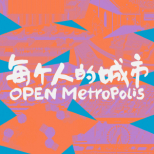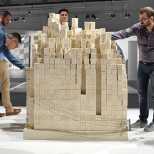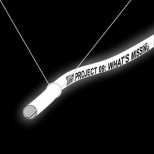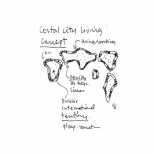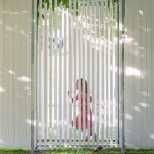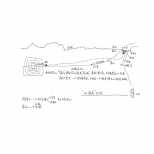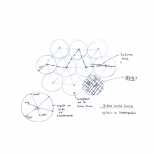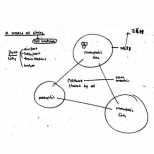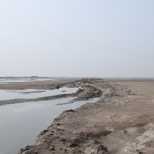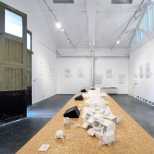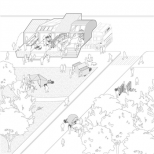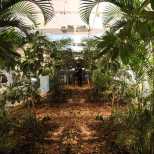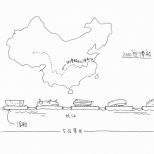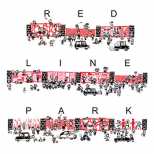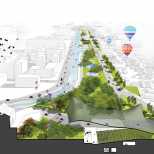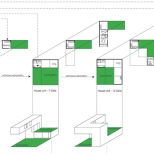Ideas
-
OPEN Metropolis ( )
OPEN Metropolis is an urban research and design project initiated by OPEN, aiming to make our city a true "city for everyone" through a light regeneration and improvement strategy called " Voids for the Needs".
-
THE ETERNAL & THE EPHEMERAL ( )
This is an art installation OPEN designed for the “Soul of City” Exhibition at Marmomac 2017, which invited designers from seven different countries to collaborate with some of Italy’s finest stone manufacturers and interpret their own understanding of the given theme, using a single building material – natural stone. The exhibition would only last four days, and stone is a rather heavy building material.
-
EXHIBITION DESIGN FOR ‘THE NEW NORMAL’ ( )
This is an exceptional exhibition design, fittingly corresponds to the large-scale group exhibition’s theme: The New Normal.
-
Museum Disappearance Project ( )
OPEN’s Exhibition design for the Shanghai Project @ Himalaya Museum This project is an experiment to break down the spatial barriers from conventional museum structure between the artwork and artwork, and between the art and the public, thus establishing a new kind of relationship between arts, in this case, the Projects, and between the Projects and the Public.
-
Coastal Living ( )
To envision a future where people all live along the coast and leave the mainland free for nature, which will become a publically accessible international vacation resort.
-
Garden in the Garden ( )
The 14th Venice Biennale, Outdoor Installation of the Chinese Pavilion
-
Shanhaiguan Plan ( )
To relocate Songzhuang, the artists’ village facing urgent threat of demolition, into the dormant old core of the coastal city Shanhaiguan, and reactivate a forgotten history. To protect those marginal art and artists; and to effectively stimulate the potential of this under developed town -- one stone two birds.
-
The 3km City ( )
To envision a future city consisting of a series of micro-cities with radius 3kmand are all connected by public transportation. Inside the micro-cities, homes, workplaces, cafés, restaurants and shops are all within walking and cycling distance.
-
World of Cities ( )
To imagine a future world with no countries but different cities; and cities are all connected by seaports, airports, railways and highways. The natural landscape in between will be shared by all.
-
An Article about Eco-cities ( )
How do we learn to stop building new eco-cities, and love our old cities? It is clear to the world that China has experienced a phenomenal growth both in terms of its urbanization and wealth over a very short period of time in recent history. It is generally predicated that by 2025, more than 350 millions people will migrate into cities, and by 2030, more than 1 billion people will be living in cities.
-
OPEN State Exhibition ( )
OPEN State is a micro-exhibition about the state of work and thoughts by OPEN Architecture. 16 projects from OPEN’s work of the recent few years are included in this exhibit, some built or will be built, others rejected or speculative, they are presented in the upper and lower lines respectively along the time-line. Each project is intentionally presented with reduced information, focusing on the concept and strategies embedded, the very important yet less tangible aspect in architectural projects.
-
MOBILE JOY STATION ( )
As an unavoidable consequence of the global urbanization, cities became a hostile environment for most of its inhabitants. Rather than being a place of communication, appropriation and production, public places are transformed into an arena where people struggle to survive: due to the increasing number of the urban population, it is more and more difficult to provide all the necessary services to everyone.
-
2nd Ring 2049 Mobile Theater ( )
2ND RING 2049 MOBILE THEATER was a Multimedia Installation Project for 2011 Beijing Design Week by OPEN Architecture to showcase one of OPEN’s urban research projects 2ND RING 2049. Two installations were designed and installed at two separated venues.
-
OPEN Nature ( )
We are living in an era of a looming environmental crisis. After 3 decades of unprecedented urban growth in China, we are seeing remarkable prosperity on the surface while facing the worst environmental problems ever seen in history.
-
Post World Expo ( )
At the request of OUTLOOK magazine, three different concepts are conceived to imagine how to deal with the 2010 shanghai world expo pavilions. By stacking them, by floating them, or by building over them, these expo pavilions will be saved without judgment on their values, beauty or nationality. While they will serve the different purpose and functions in the future, the symbols of this phenomenal extravaganza will be transformed and integrated into people’s life, and ultimately the city. Better city better life. Be thrifty, no waste.
-
Red Line Park ( )
This project is adapted for 2009 SZHK biennale from an urban research project titled Red Line Park. It is NOT to be viewed as articulated constructs or designer objects of some sorts, but rather a built sample of a grass root urban initiative which encourages residents of gated communities to participate in the process of gradually turning walled communities into open communities and bringing parks to everyone’s door steps.
-
2nd Ring Beijing 2049 ( )
The vision is set for 2049, 100-year anniversary of communist China, with the hope for injecting idealistic and forwarding thinking into today’s architectural discourse, which is more often than not driven by the practicality of past decades’ economic boom and the fashionable form making. Radically departing from the current mode of urban development, this research project investigates the possibilities of transforming a unique member of Beijing’s ring road highway system, the 2nd ring road, into a park zone with normal urban streets and active urban life, by 2049.
-
Mass Customization ( )
Mass Customizable Housing (MCH) is a program designed to democratically and interactively engage the ordinary end users in the process of making one’s ideal house. Each house is customized to fit individual family’s life style; each housing community is collectively planned and tailored to the need of co-op residents. It is a challenge to the currently accepted social code – only those with enough resources can afford to have architect designed (customized) dwellings, while the majorities have their individual life styles defied by homogeneous collective housing. It also aims to bring a revolution to industries related to housing constructions.
